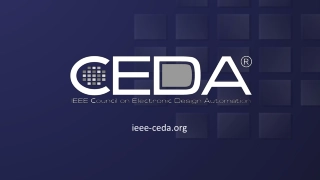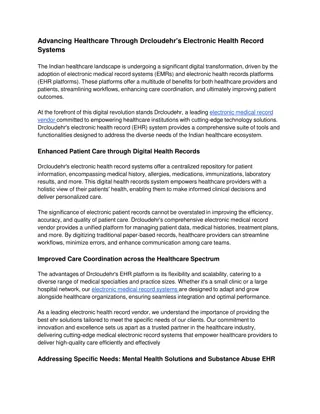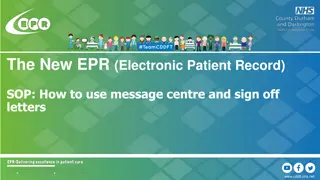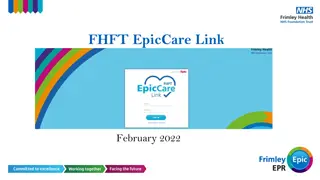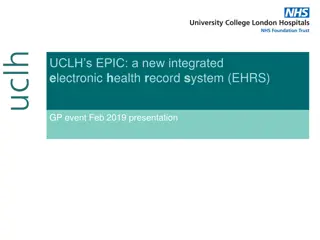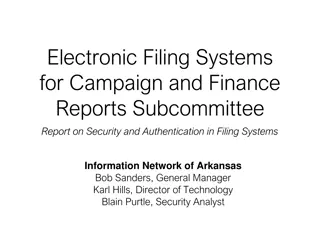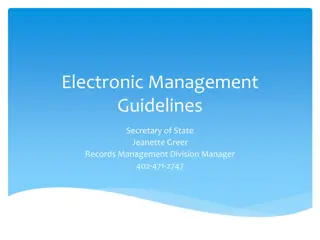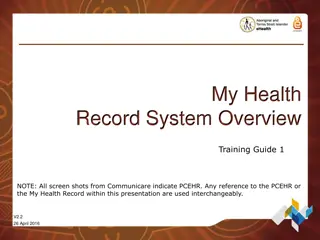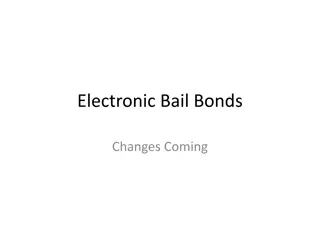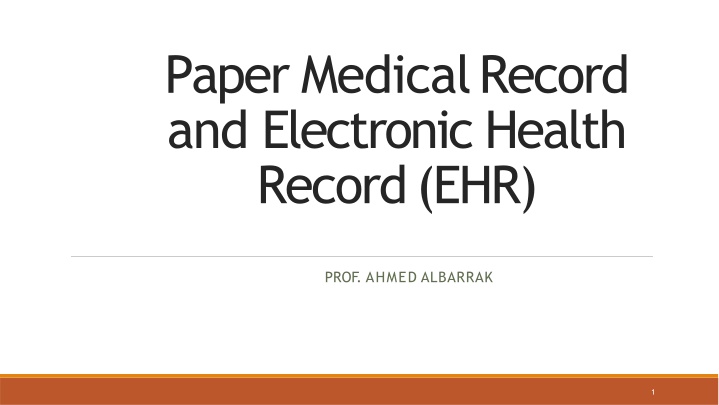
The Role of Medical Records in Healthcare
Explore the significance of traditional paper-based medical records and electronic health records (EHR), along with their advantages, disadvantages, and main purposes in healthcare documentation. Learn about the inputs, outputs, and roles of medical records in transcription, coding, quality check, security administration, training, and research.
Download Presentation

Please find below an Image/Link to download the presentation.
The content on the website is provided AS IS for your information and personal use only. It may not be sold, licensed, or shared on other websites without obtaining consent from the author. If you encounter any issues during the download, it is possible that the publisher has removed the file from their server.
You are allowed to download the files provided on this website for personal or commercial use, subject to the condition that they are used lawfully. All files are the property of their respective owners.
The content on the website is provided AS IS for your information and personal use only. It may not be sold, licensed, or shared on other websites without obtaining consent from the author.
E N D
Presentation Transcript
Paper Medical Record and Electronic Health Record (EHR) PROF. AHMED ALBARRAK 1
Traditional Paper-based MedicalRecord Purpose: to record observations and could be reminded ofpatients' details. Inputsources: History Notes Lab Radiology Reports Coding Other 2
Traditional Paper-based MedicalRecord Outputs: 3
Paper based medical records dis(advantages) Find the record (lost, being used elsewhere) Find data within the record (poorly organized, missing) Read data (legibility) Update data (manual) Record fragmentation Moving records Redundancy (re-enter data in multiple forms) Statistics and Research (can not search across patients) Passive (no automated decision support) 4
MainPurpose of Documentation Remembering what youdid and why; form basis for historicalrecord Conveying information to MedicalT eam members; Support communication amongproviders Coding andBilling Legalissues 5
MainPurpose of Documentation Anticipate future healthproblems Record standard preventivemeasures Identify deviations from expected trendsexample; growthchart Support clinicalresearch 6
Rememberingwhatwasdoneandwhy Legibility Ease ofsearch Granularity ofinformation Miss filings Lostcharts 7
Disadvantages Learning curve Slower-time Security/privacy concerns Cost, initial cost,running and maintenance Upgrades and depreciation 8
Role of medicalrecords Transcription Coding Quality check Security administration Training Research
Block Diagram showing multiple systems feeding into patient database. The Database Interface or InterfaceEngine may perform intelligentfiltering, translatingand alertfunctions(page396,Shortliffe) 10
Medicalrecords Medical records serves avarietyoffunctionsfororganizations not involved directly incare: Insurers(governmentand private)to justifypayment formedicalservices rendered, and to detectfraud. Quality reviews,administrativereviews,and utilizationstudies tomanage the business aspects of healthcare. Used for societal purposes, such as, social service and welfare system management,lawenforcement,screeningand licensing and determining life insuranceeligibility. Medical research, public healthmanagement Education and medicaltraining
EMR A general term describing computer-based patient record systems. It is sometimes extended to include other functions likeorder entry formedicationsand tests, amongst other common functions. EMR (Electronic Medical Record) the set of databases (lab, pharmacy, radiology, clinical notes, etc.) that contains the health informationforpatientswithinagiveninstitutionor organization 12
*EMR Components* Resultsreporting Datarepository Decisionsupport Clinical messaging and communications; i.e.e-mail Documentation Orderentry 13
Electronic Health Records(EHR) Definition:arepository ofelectronicallymaintainedinformationaboutanindividual s healthstatusandhealthcare,storedsuchthatitcanserve themultiplelegitimateuses and users of therecord. Otherdefinition:Longitudinalelectronicrecordofpatienthealthinformationgenerated byoneor moreencountersinanycaredeliverysetting ElectronicHealthRecordSystem:includestheactivetoolsthatareusedtomanagethe information. Interoperabilitystandardstoexchangeinfooutsideasinglehealthcaredeliverysystem. Supports other care-related activities directly or indirectly evidence-baseddecision support, quality management, and outcomesreporting 14
Computer-Based Patient Record (CPR) Comprehensive lifetimerecord AttributesidentifiedbytheInstituteof Medicine (IOM) providethe basis fortoday sunderstanding oftheEHR 15
Electronic Medical Record vs.Paper-Based Record Function Paperrecord One location One format Low Difficult toextract Low Yes Yes None EMR Availability andaccessibility Display Security Data Legibility Duplication ofrecords Duplication oftests Patientinteraction Multiple Severalformat High Should be easy toextract More No canallbelinked Rare Full if desired 16
FunctionalComponentsofanElectronic Medical RecordSystem An EHRis not simplyan electronicversion ofthe paperrecord. 1. Integrated view of patientdata 2. Clinician orderentry 3. Clinical decisionsupport 4. Access to knowledgeresources 5. Integrated communication and reportingsupport 17
Integrated View ofPatient Data Available at anytimeanywhere Clinical Data has complexityand diversity Clinical Data requiresdifferent format andterminology Requires standards like HL7to integrate the clinicaldata Local terminologies needs tobe translated into standardized terminologies (Source:CourtesyofWorldVistA(worldvista.org)andISI Group(www.isigp.com),2012) 18
Integrated View ofPatient Data InterfaceEnginehelps tobecomemediatorforEHRto be connected to other vendor systems( Tracking system, Imaging system, Medication dispenseretc) Various views: Flowsheet, Chronological views, SummaryViews 19
Clinician OrderEntry Electronicorderentrycanimprovehealthcareatseverallevels (computerized physician order entry(CPOE)): -Reduce errors andcosts. -Deliver decision support at the point where clinical decisions are beingmade. 20
Integrated Communicationand ReportingSupport Communication toolscouldbean integratedpartoftheEHR system. Patienthandoffs. Health Information Exchanges ( HIE) 21
PatientBenefits Decreased wait time fortreatment Increased access/control over healthinformation Increased use of best practices/decisionsupport Increased ability to ask informedquestions Quicker turnaround time for orderedtreatments 22
PatientBenefits Greater clarity to dischargeinstruction Increased responsibility for owncare Alertsand remindersforappointments and scheduled tests Increased satisfaction and understanding ofchoices Issue:When apatientcouldaccesshis/herown healthinformation likeinotheronlineservices? (Pros,Cons) 23
* Data Ownership * Papermedicalrecordsarethepropertyof thecreatorswithfull responsibilities: storage,accuracy Many providersshare/updatethesame electronicdata inmany sites,who istheresponsibleownerinEHR? 24
CaregiverResistance EHRs areperceivedas lackingessentialfeaturesand awkward/inconvenience touse Some people havebeenunable /unwillingtouse computers! Professionals don t want to change their familiar , traditional practices Ratherpaypenaltiesthan bearEHRimplementingcost May even refusepatients Need incentives 25
EnablingFactors: 1. Comprehensiveness ofinformation. 2. Durationof use and retentionofdata. 3. Degree of structure ofdata. 4. Ubiquity of access. 26
FundamentalIssues: DataValidation: Range checks (out of rangevalue) Patternchecks Computed checks(values have the correctmathematical relationship) Consistencychecks Delta checks (large and unlikely differences betweenthe values) Spellingchecks 27
FundamentalIssues: Datadisplay:Once storedinthecomputer,datacanbepresented in numerous formats fordifferentpurposes without further entry work TIMELINEGRAPHS TIMELINEFLOWSHEETS 28
DataDisplay Dynamic Search Search tools help the physician to locaterelevant data. TheEHRcanthendisplaythesedataas specialized presentation formats (e.g., flowsheets orgraphics). Summaries andSnapshots 29
Fundamentalissues: Query and SurveillanceSystems Findrecordsof patientsthatsatisfy pre-specifiedcriteriaand export selecteddata. Clinicalcare Clinicalresearch Qualityreporting Retrospectivestudies Administration (e.g. resourceconsumption) 30
EHRAdoptioninSaudiArabia Eastern Province study(Bah, Alharthi, El Mhalli,2011). 60% 50% 40% 30% 20% 10% 0% EHR Paper_ based.85 50% 36% 15% 14% fully-functioningEHR inprogress No 85% level of EHR functions (Mahalli,2015). 31
BarriersofEHRinSaudiArabia: 1. Human Barriers: Lackof awarenessofthe importance and benefitsofEHR, knowledge and experience of usingEHRs, experience of computer applications. Negative beliefs and impressionsabout EHRsand about their abilityto use EHRs 2. Financial Barriers: High initial cost of EHRsimplementation. High operationand maintenance costs ofEHRs. Lackof feasibilitystudiesthat show the benefitsversus costsofimplementing and usingEHRs. 32
BarriersofEHRinSaudiArabia: 3. Legal and regulatorybarriers: Lack of policies that govern EHRs onboth hospital and national levels. Using EHRsmaythreaten confidentiality ofhealth information. 4. Organizationalbarriers: Workflow needs redesignto match with EHRs. Hospital management doesn t havethe necessaryexperience to choose & implement the bestEHRs. Hospital management doesn t provide the necessarytrainingfor the staffon usingEHRs. 33
BarriersofEHRinSaudiArabia: 5. Technicalbarriers: Computersand networks have alotofmaintenance problems. EHRsarenot satisfying differentusers needs. Themaindifficultywith EHRsisdataentry and dataretrieval. 6. Professionalbarriers: Lackofmotivation tolearnand trainon using EHRs. EHRs slows down work/decreasesproductivity. 34
Future Trends ofEHR: Patient access willincrease, Cloud technology forEHR. Movement toward a nationalizeddatabase. Mobile accessibility. 35
SuggestedReadings: Shortliffe, E. H., & Cimino, J. J. (Eds.). (2013). Biomedical informatics: computer applications in health careandbiomedicine.SpringerScience& Business Media. Menachemi,N.,& Collum,T.H.(2011).Benefitsanddrawbacksofelectronichealthrecord systems. Risk ManagHealthc Policy, 4, 47-55. Bah,S.,Alharthi,H.,& ElMahalli,A.A.(2011). Annualsurveyon thelevelandextentofusageof electronic health records in government-related hospitals in Eastern Province, Saudi Arabia.Perspectives in Health Information Management,8(1),102-153. Mahalli, A. E. (2015). Adoption and Barriers to Adoption of Electronic Health Records by Nurses in ThreeGovernmentalHospitalsinEasternProvince,SaudiArabia.PerspectivesinHealthInformation Management,12(Fall). Khalifa, M. (2013). Barriers to health information systems and electronic medical records implementation.A fieldstudyofSaudiArabianhospitals. ProcediaComputerScience,21,335-342. 36
Bestwishes Albarrak@ksu.edu.sa 37


